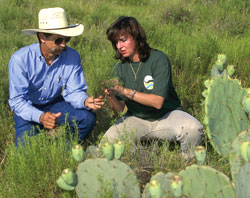There’s nothing sexy about monitoring, but there’s probably no other single action that will keep rangelands healthier than checking vegetation. Measuring annual livestock use, documenting climatic and other potential impacts to the vegetation and watching the long-term trend in range health will do more to suggest management actions than any other use of a rancher’s time.

Martha Artega, NRCS public affairs specialist, and Joel Torres, NRCS district conservationist, survey rangeland quality near Zapata, Texas. Photo by NRCS
Researchers know they face obstacles in getting private landowners on board.
“Monitoring on private rangeland hosts a unique set of challenges compared to the larger monitoring programs that are much more prevalent on public lands,” says North Dakota State University’s Amanda Hancock. “First and foremost, is the persistent question of ‘Why should I monitor? Why should I care?’ ”
While public lands are subject to the scrutiny of the general public, private rangelands are often out of sight, Hancock says. “Why should a manager bother with the hassle of monitoring when there are no direct consequences if he or she does not?”
No federal agencies grant grazing permits or lease allotments on private lands, so the data collected are largely dependent on producer ambition and knowledge of rangeland ecology. While researchers encourage both quantitative and qualitative data collection, they often receive qualitative data such as repeat photo points because photos are simple, easy and require few technical skills. Ideally, Hancock and others would like to see rangeland managers install permanent transects, identify plants, clip biomass, determine cover class and analyze those data.
Acknowledging that detailed monitoring requires both knowledge and time, researchers like Hancock work with managers to set up practices they can do by themselves, such as repeat photo points, identifying eight to 10 key species and knowing indicator species for the plant communities in which they have permanent photo points established.
Nevada rancher Agee Smith agrees wholeheartedly with the importance of monitoring.
“How can you know what’s going on unless you monitor?” he asks. “We found that out the hard way after a fire burned 11,000 acres of our range. We needed monitoring data that we didn’t have for decisions we really needed to make.”
Producers need to monitor more than just their forage, says Hancock. Changes in the size of cattle over the years have made a huge impact on rangelands. Fifty years ago, cows were roughly 1,000 pounds. Today, although there is some regional variation, cows are closer to 1,300 pounds.
“Increased cattle size means a need for more feed, but most producers have not substantially increased their land base in the last 50 years,” Hancock says. “So we are beginning to see rangelands that are not being managed in a sustainable manner.”
In Colorado, 25 national forest grazing permittees from the Cumbres and LaManga Cattle Association learned to use line transects, photo points, clipping studies, stubble height, cover, frequency and utilization cages to evaluate their ranches. They studied such things as animal and insect contacts, grazing use, stocking rates, forage production and riparian flood management during a two-day monitoring workshop.
The hard work paid off says Marvin Reynolds, a Colorado extension agent who served as a technical adviser for a SARE farmer/rancher grant project focusing on range improvement.
“The permittees on the forest were at risk of losing 33 percent of their time and number of head on the permit,” Reynolds said. “Because they began monitoring and have used the monitoring to assist in managing their herd, they have maintained the days and the number of head.”
During the severe drought of 2002, the permittees worked with the Forest Service to alter grazing patterns and ended up losing less of their annual allotment than their neighbors, Reynolds says.
Another positive benefit resulted from the mutual respect that grew between the landowners and the Forest Service when they could have become potential adversaries. “Before, it was all antagonistic,” Reynolds says, “whereas now, they cooperate.”
Beyond cooperation, the forest graziers’ work was held up as a pattern for other allotment holders in 2004 after the 2002 drought. The permittees train their range riders to monitor and evaluate pastures while working on the range. The Forest Service has allowed the allotment holders to move animals on their own when they felt a pasture was done.
The ranchers apparently think their monitoring efforts are worthwhile. “Over 25 producers are currently using some of the techniques they learned on some part of their operation,” Reynolds says. And of an additional 17 producers trained in these techniques at other workshops, 13 have said they are using one or more techniques on their land.
